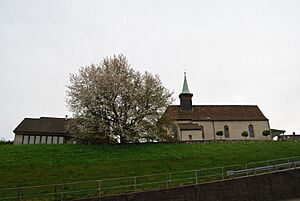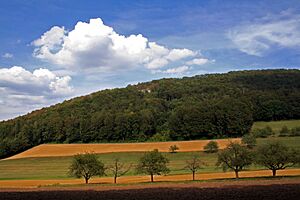Starrkirch-Wil facts for kids
Quick facts for kids
Starrkirch-Wil
|
||
|---|---|---|
|
||
| Country | Switzerland | |
| Canton | Solothurn | |
| District | Olten | |
| Area | ||
| • Total | 1.84 km2 (0.71 sq mi) | |
| Elevation | 419 m (1,375 ft) | |
| Population
(Dec 2020 )
|
||
| • Total | 1,753 | |
| • Density | 952.7/km2 (2,468/sq mi) | |
| Postal code |
4656
|
|
| Surrounded by | Aarburg (AG), Dulliken, Oftringen (AG), Olten (SO) | |
Starrkirch-Wil is a small town, also called a municipality, in Switzerland. It is located in the Olten area within the canton of Solothurn.
Contents
What is the History of Starrkirch-Wil?
The village of Starrkirch was first mentioned in old writings in the year 1036. Back then, its name was Starchenchilcha. Later, in 1288, the village of Wil was also mentioned, known as Wile.
Where is Starrkirch-Wil Located?
Starrkirch-Wil covers an area of about 1.84 square kilometers (0.71 square miles). A large part of this land, almost half, is covered by forests. About a quarter of the land is used for farming. The rest of the area has buildings and roads.
This municipality is found in the Olten district. It sits between the Aare river and the northern side of the Engelberg mountain range. Starrkirch-Wil includes two main villages, Starrkirch and Wil. It also has a settlement called Wartburg and the area around the old Vordere Wartburg Castle ruins, which people often call Sälischlössli.
What Does the Starrkirch-Wil Coat of Arms Look Like?
The official design of the town's coat of arms is quite simple. It shows a silver (white) church on a blue background. The church has black outlines for its stones.
Who Lives in Starrkirch-Wil?
Starrkirch-Wil has a population of about 1,700 people. A small part of the population, about 11.8%, are people from other countries. Over the last ten years, the number of people living here has grown by almost 28%.
Most people in Starrkirch-Wil speak German. This is about 93% of the population. The next most common language is Italian, followed by Spanish. Only a few people speak French.
In 2008, the population was almost evenly split between males and females. About 49.8% were male and 50.2% were female. Most residents are Swiss citizens.
Many people living in Starrkirch-Wil were born in the same canton or elsewhere in Switzerland. About 11.5% of the residents were born outside of Switzerland.
Population Changes Over Time
The number of people living in Starrkirch-Wil has changed over many years. For example, in 1739, there were only 98 people. By 1970, the population had grown to 1,124. In 2000, it reached 1,253 people.
How Do People Work and Live in Starrkirch-Wil?
In 2010, the unemployment rate in Starrkirch-Wil was low, at 3%. This means most people who wanted to work had jobs.
Types of Jobs
There are different types of jobs in the municipality:
- A few people work in the primary sector, which means jobs like farming.
- Some people work in the secondary sector, which includes jobs in manufacturing and construction.
- Most people work in the tertiary sector. This includes jobs in sales, transportation, hotels, restaurants, education, and healthcare.
Many people who live in Starrkirch-Wil travel to other towns for work. About 18.7% of working people use public transportation to get to their jobs. A larger number, about 59.4%, use their own cars.
Homes and Households
In 2000, there were 528 private households in Starrkirch-Wil. On average, about 2.4 people lived in each household. Some households had only one person, while others had five or more.
Most of the buildings where people live are single-family homes. Many of these homes were built between 1946 and 1960. There are also apartments available. The most common apartment size has four rooms. Most apartments are lived in all the time.
What Religions are Practiced in Starrkirch-Wil?
Based on information from 2000, many people in Starrkirch-Wil are Roman Catholic. A good number also belong to the Swiss Reformed Church.
Some people follow other Christian churches, including the Christian Catholic Church or Orthodox churches. There are also people who are Islamic or Buddhist. A significant number of people do not belong to any church or have no specific religion.
How is Education in Starrkirch-Wil?
Education is important in Starrkirch-Wil. Many adults have completed high school. A good number have also gone on to get higher education from a university or a specialized college.
School System
During the 2010-2011 school year, 162 students were in the Starrkirch-Wil school system.
- Young children can attend two years of non-required Kindergarten.
- Students then go to six years of primary school.
- After primary school, students attend three years of required secondary school. However, all secondary students from Starrkirch-Wil go to school in a nearby town.
In 2000, most students from Starrkirch-Wil attended schools outside the municipality.
See also
 In Spanish: Starrkirch-Wil para niños
In Spanish: Starrkirch-Wil para niños






